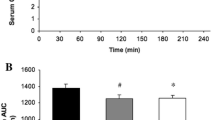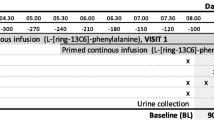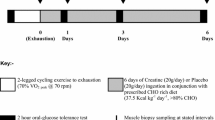Summary
Five healthy male subjects exercised for 3 min at a workload equivalent to 100% \(\dot V_{{\text{O}}_{{\text{2 max}}} } \) on two separate occasions. Each exercise test was performed on an electrically braked cycle ergometer after a four-day period of dietary manipulation. During each of these periods subjects consumed either a low carbohydrate (3±0%, mean ±SD), high fat (73±2%), high protein (24±3%) diet (FP) or a high carbohydrate (82±1%), low fat (8±1%), low protein (10±1%) diet (CHO). The diets were isoenergetic and were assigned in a randomised manner. Muscle biopsy samples (Vastus lateralis) were taken at rest prior to dietary manipulation, immediately prior to exercise and immediately post-exercise for measurement of pH, glycogen, glucose 6-phosphate, fructose 1,6-diphosphate, triose phosphates, lactate and glutamine content. Blood acid-base status and selected metabolites were measured in arterialised venous samples at rest prior to dietary manipulation, immediately prior to exercise and at pre-determined intervals during the post-exercise period. There was no differences between the two treatments in blood acid-base status at rest prior to dietary manipulation; immediately prior to exercise plasma pH (p<0.01), blood \(P_{{\text{CO}}_{\text{2}} } \) (p<0.01), plasma bicarbonate (p<0.001) and blood base-excess (p<0.001) values were all lower on the FP treatment. There were no major differences in blood acid-base variables between the two diets during the post-exercise period. Compared with the CHO diet, the FP diet resulted in plasma alanine (p<0.05), blood lactate (p<0.05), and plasma glutamine (p<0.01) levels being lower immediately prior to exercise; plasma free fatty acids (FFA; p<0.05), glycerol (p<0.01), urea (p<0.001) and blood 3-hydroxybutyrate (3-OHB; p<0.01) levels were all higher. After the FP diet blood alanine, lactate and plasma glutamine levels were lower for the whole or the majority of the post-exercise period, while the concentrations of plasma FFA, glycerol, urea and blood 3-OHB and glucose were higher. There was no difference between the diets in pre-exercise glucose and insulin levels and post-exercise insulin levels. There was no difference in muscle pH between the two diets immediately prior to exercise; the decline in muscle pH was 104% greater during exercise on the FP diet resulting in a significant difference in post-exercise pH (p=0.05). The FP diet resulted in 23% decline in muscle glutamine levels, resulting in lower levels (p<0.05) immediately prior to exercise. Exercise had no influence on muscle glutamine levels after the FP diet but produced a 17% decline on the CHO diet. Muscle glycogen content increased by 23% on the CHO diet, but was unchanged after the FP diet. This resulted in levels being significantly different prior to exercise (p<0.05). The decline in muscle glycogen content during exercise was 50% greater on the CHO diet. There were no differences when comparing the two dietary treatments in any of the pre-exercise glycolytic intermediates measured. Immediately post-exercise glucose 6-phosphate levels were 22% higher and fructose 1,6-diphosphate levels were 130% lower on the FP diet. There were no differences between the two diets in muscle triose phosphate or lactate levels at any point of the study. The present study demonstrates that a FP diet can induce metabolic acidosis and may reduce pre-exercise muscle buffering capacity, which may then influence subsequent exercise performance. However, this appears not to influence the efflux of H+ from muscle during and after high intensity exercise.
Similar content being viewed by others
References
Dill DB, Costill DL (1974) Calculation of percentage changes in volumes of blood, plasma, and red cells in dehydration. J Appl Physiol 37:247–248
Donaldson SKB, Hermansen L, Bolles L (1978) Differential, direct effects of H+ on Ca2+ — activated force of skinned fibres from the soleus, cardiac and adductor magnus muscles of rabbits. Pflügers Arch 376:55–65
Felig P (1977) Amino acid metabolism in exercise. In: Milvy P (ed) The marathon physiological, medical, epidemiological and psychological studies. Ann NY Acad Sci 301:56–63
Field (1960) Glycogen deposition diseases. In: The metabolic basis of inherited disease. McGraw-Hill, New York, pp 156–207
Folin (1905) Laws governing the chemical composition of urine. Am J Physiol 13:66–115
Forster HV, Dempsey JA, Thomson J, Vidruk R, DoPico GA (1972) Estimation of arterial \(P_{{\text{O}}_{\text{2}} } ,P_{{\text{CO}}_{\text{2}} } \) pH and lactate from arterialised venous blood. J Appl Physiol 32:134–137
Goldstein L (1980) Adaptation of renal ammonia production to metabolic acidosis. Physiologist 23:19–25
Gollnick PD, Pernow B, Essen B, Jansson E, Saltin B (1981) Availability of glycogen and plasma FFA for substrate utilisation in leg muscle of man during exercise. Clin Physiol 1:27–42
Greenhaff PL, Gleeson M, Maughan RJ (1987a) The effects of dietary manipulation on blood acid-base status and the performance of high intensity exercise. Eur J Appl Physiol 56:331–337
Greenhaff PL, Gleeson M, Maughan RJ (1987b) Diet induced metabolic acidosis and the performance of high intensity exercise in man. Eur J Appl Physiol (in Press)
Harris RC, Hultman E, Nordesjo LO (1974) Glycogen, glycolytic intermediates and high-energy phosphates determined in biopsy samples of musculus quadriceps femoris of man at rest. Methods and variance of values. J Clin Lab Invest 33:109–120
Hermansen L (1981) Muscular fatigue during maximal exercise of short duration. Med Sport 13:45–52
Hultman E (1967) Physiological role of muscle glycogen in man with special reference to exercise. Circ Res [Suppl 1] 20–21:99–111
Hultman E, Del Canale S, Sjoholm H (1985) Effect of induced metabolic acidosis on intracellular pH, buffer capacity and contraction force of human skeletal muscle. Clin Sci 69:505–510
Jansson E (1981) Acid soluble and insoluble glycogen in human skeletal muscle. Acta Physiol Scand 113:337–340
Katz A, Sahlin K, Henriksson J (1986) Muscle ATP turnover rate during isometric contraction in humans. J Appl Physiol 60:1839–1842
Lavoie JM, Bonneau M-C, Roy J-Y, Brisson GR, Helie R (1987) Effects of dietary manipulations on blood glucose and hormonal responses following supramaximal exercise. Eur J Appl Physiol. 56:109–114
Lund P (1985) Glutamine. UV-method with glutaminase and glutamate dehydrogenase. In: Bergmeyer HU (ed) Methods of enzymatic analysis, vol VIII Metabolites 3: Lipids, Amino Acids and Related Compounds. VCF, Weinheim, pp 357–363
Maughan RJ, Greenhaff PL, Gleeson M, Fenn CE, Leiper JB (1987) The effect of dietary carbohydrate intake on the metabolic response to prolonged walking on consecutive days. Eur J Appl Physiol 56:538–591
McCance RA, Widdowson ED (1960) The composition of foods. MRC Special, Report Series No. 297, London HMSO
Newsholme EA, Start C (1973) Regulation in metabolism. J Wiley and Sons, Chichester
Newsholme EA, Leech AR (1983) Biochemistry for the medical sciences. J Wiley and Sons, Chichester
Richter EA, Galbo H (1986) High glycogen levels enhance glycogen breakdown in isolated contracting skeletal muscle. J Appl Physiol 61:827–831
Sahlin K (1978) Intracellular pH and energy metabolism in skeletal muscle of man. Acta Physiol Scand [Suppl 455] 1–56
Sahlin K, Harris RC, Nylind B, Hultman E (1976) Lactate content and pH in muscle samples obtained after dynamic exercise. Pflügers Arch 367:143–149
Spriet LL, Soderlund K, Hultman E (1987a) pH measurement in human skeletal muscle samples: effect of phosphagen hydrolysis. J Appl Physiol 61:1949–1954
Spriet LL, Soderlund K, Bergstrom M, Hultman E (1987b) Skeletal muscle glycogenolysis, glycolysis, and pH during electrical stimulation in men. J Appl Physiol 62:616–621
Tesch P (1980) Muscle fatigue in man with special reference to lactate accumulation. Acta Physiol Scand [Suppl 480] 1–40
Wahren J, Ahlborg G, Felig P, Jorfeldt L (1971) Glucose metabolism during exercise in man. In: Pernow B, Saltin B (eds) Muscle metabolism during exercise. Plenum Press, New York, pp 189–204
Author information
Authors and Affiliations
Rights and permissions
About this article
Cite this article
Greenhaff, P.L., Gleeson, M. & Maughan, R.J. The effects of diet on muscle pH and metabolism during high intensity exercise. Europ. J. Appl. Physiol. 57, 531–539 (1988). https://doi.org/10.1007/BF00418458
Accepted:
Issue Date:
DOI: https://doi.org/10.1007/BF00418458




